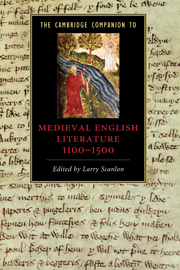Book contents
- Frontmatter
- Introduction
- Part I Contexts, genres, and traditions
- 1 Re-inventing the vernacular: Middle English language and its literature
- 2 Textual production and textual communities
- 3 Religious writing: hagiography, pastoralia, devotional and contemplative works
- 4 Romance
- 5 Dialogue, debate, and dream vision
- 6 Drama
- 7 Lyric
- 8 Lollard writings
- Part II Authors
- Guide to further reading
- Index
3 - Religious writing: hagiography, pastoralia, devotional and contemplative works
from Part I - Contexts, genres, and traditions
Published online by Cambridge University Press: 28 November 2009
- Frontmatter
- Introduction
- Part I Contexts, genres, and traditions
- 1 Re-inventing the vernacular: Middle English language and its literature
- 2 Textual production and textual communities
- 3 Religious writing: hagiography, pastoralia, devotional and contemplative works
- 4 Romance
- 5 Dialogue, debate, and dream vision
- 6 Drama
- 7 Lyric
- 8 Lollard writings
- Part II Authors
- Guide to further reading
- Index
Summary
The bulk of extant Middle English literature is made up of a wide variety of religious works. This chapter will deal with three prominent categories: hagiography, or the narrative presentation of the lives of saints and the holy family; contemplative and devotional writings, or mystical and meditative presentations of the desire for not just salvation, but perfection; and pastoralia, or edification in matters of doctrine by sermons, catechetical texts, and other pastoral writings. It should be stressed that these headings represent differences of emphasis and not unbridgeable distinctions, for catechetical purposes may be fulfilled by a saint's life and catechetical manuals may offer a reader the aesthetic pleasure provided by narrative. In fact, no literary form can be limited to only one function alone, and no function can be fulfilled exclusively by one type of literature. Moreover, prominent and broad as these categories are, they do not include, for example, descriptions of ritual practice (religious, but intended as workaday guides, especially to the administration of the sacraments), or books on monastic organization (religious, but often meant to be more practical than inspirational), as well as philosophical works like Middle English translations from Cicero (inspirational and ethical, but not strictly speaking religious). Middle English works of religious inspiration were produced in an environment that tended to favor their preservation in manuscripts, unlike more ephemeral texts such as drama or some lyric poetry. Nevertheless, there is no doubting their preponderance among all vernacular works produced in the Middle English period or their cultural importance.
- Type
- Chapter
- Information
- Publisher: Cambridge University PressPrint publication year: 2009
- 4
- Cited by

